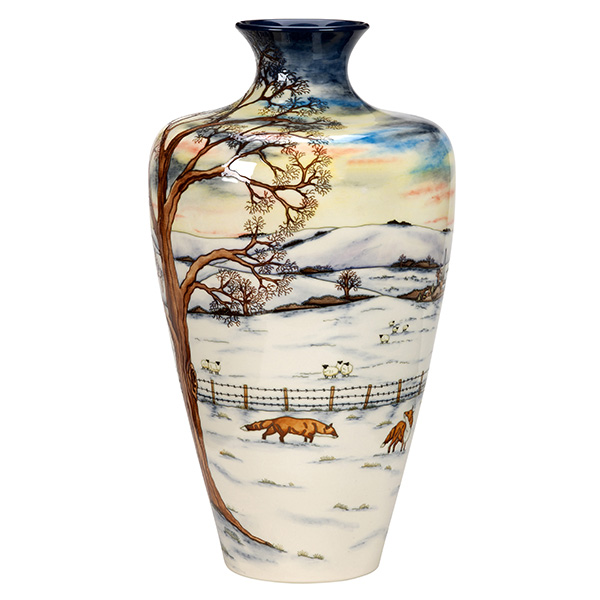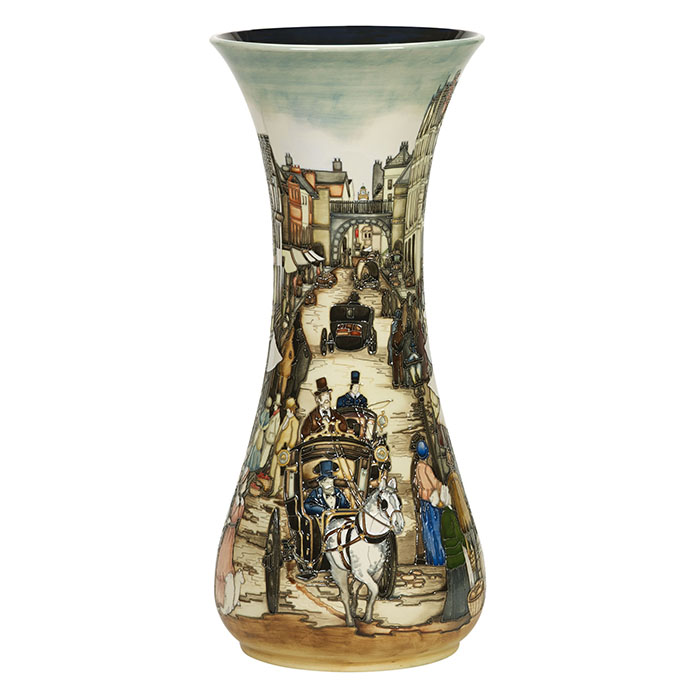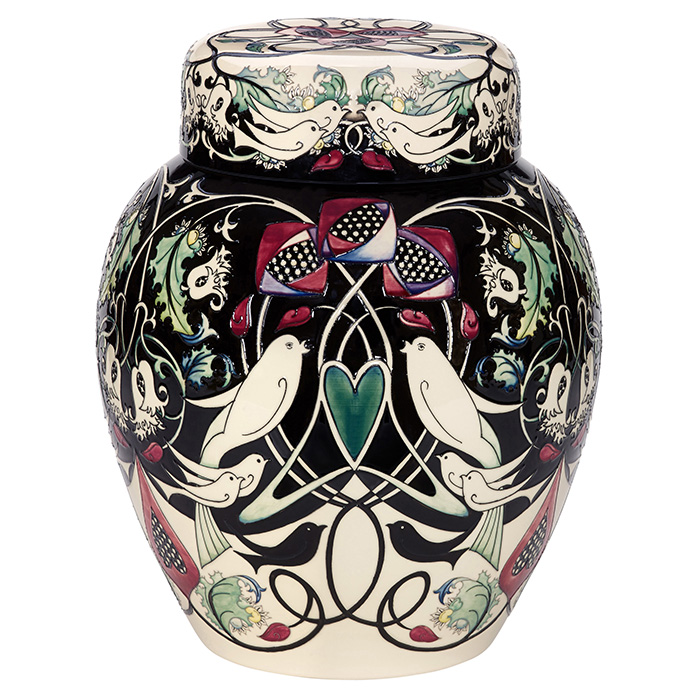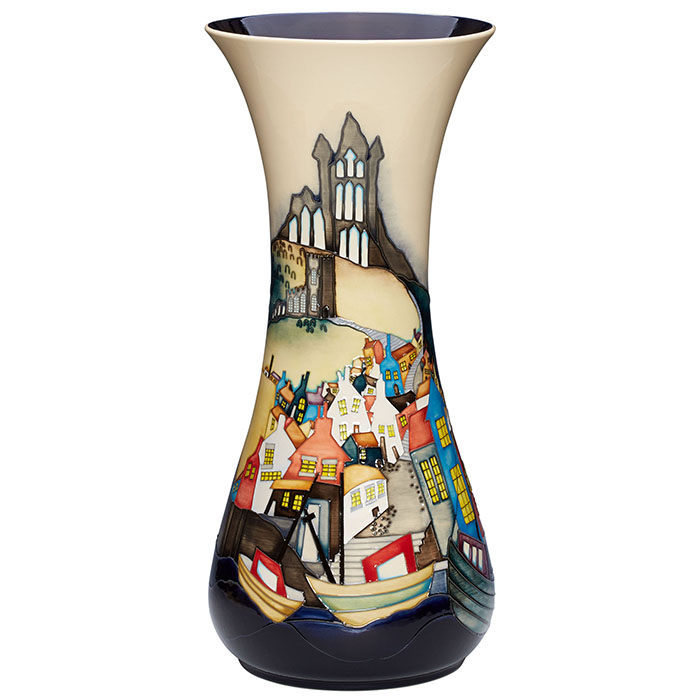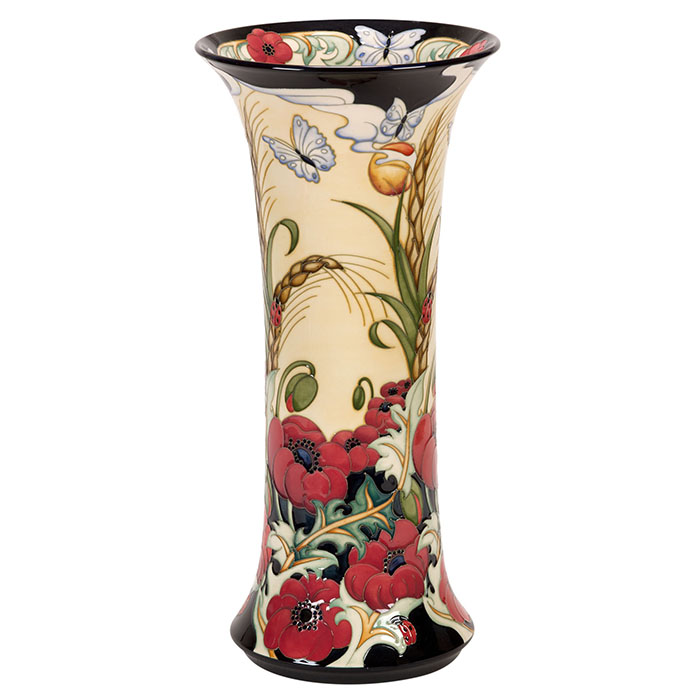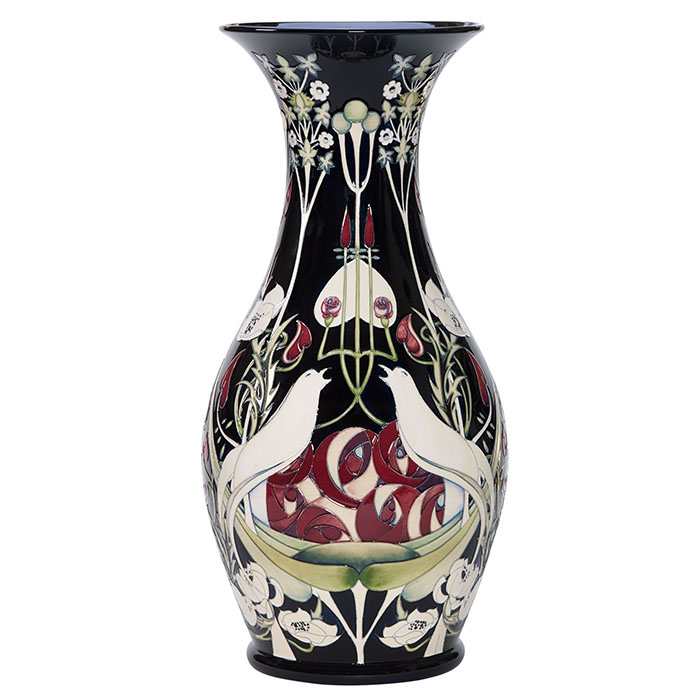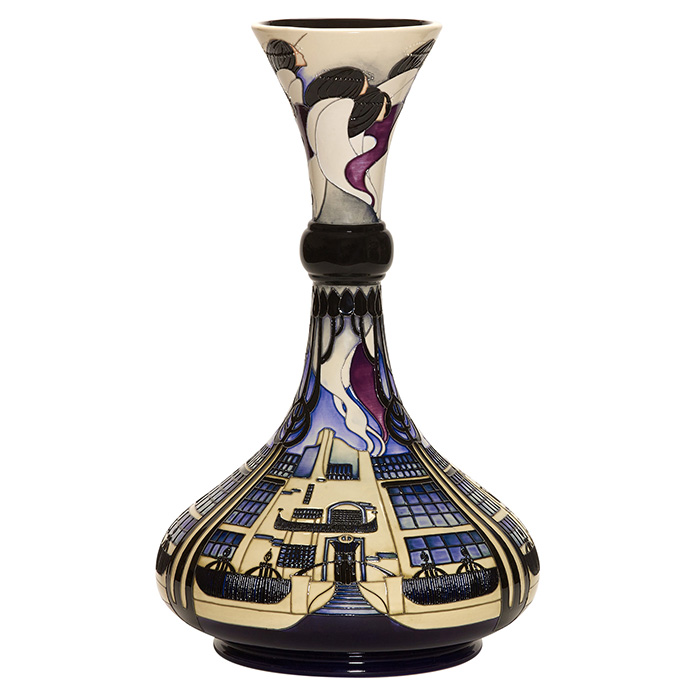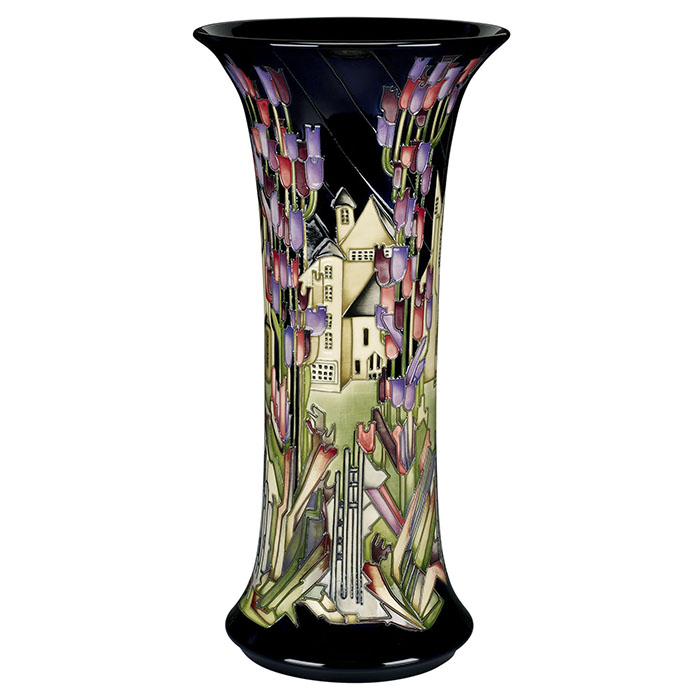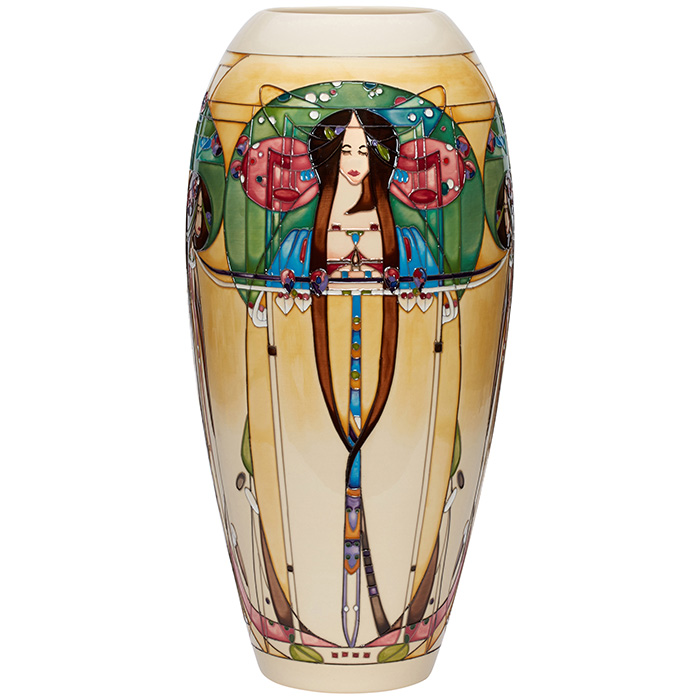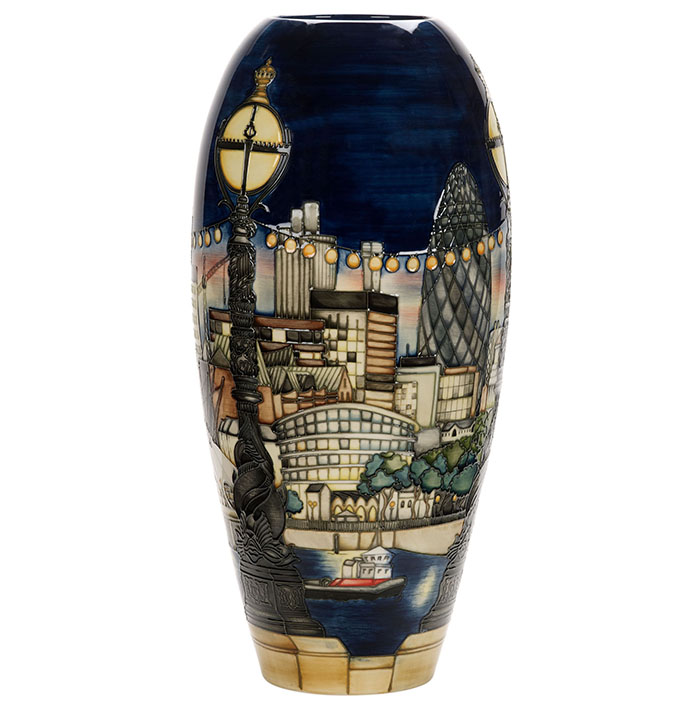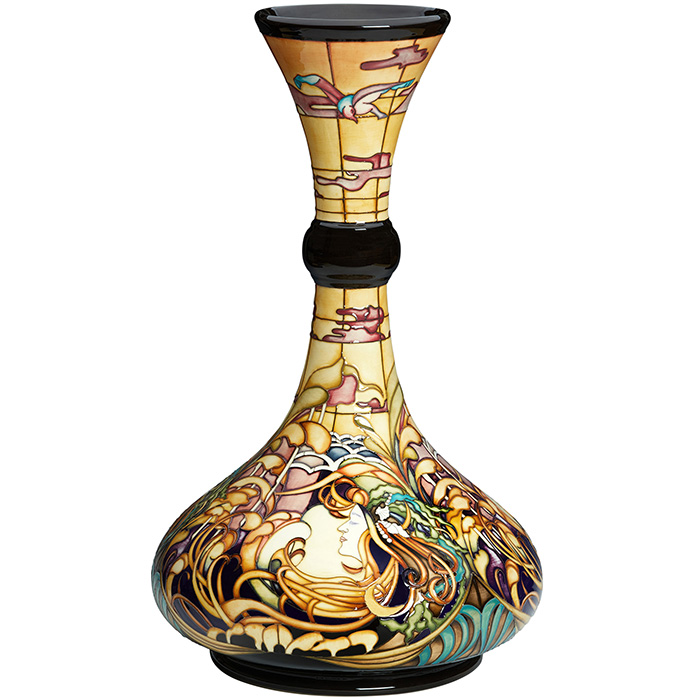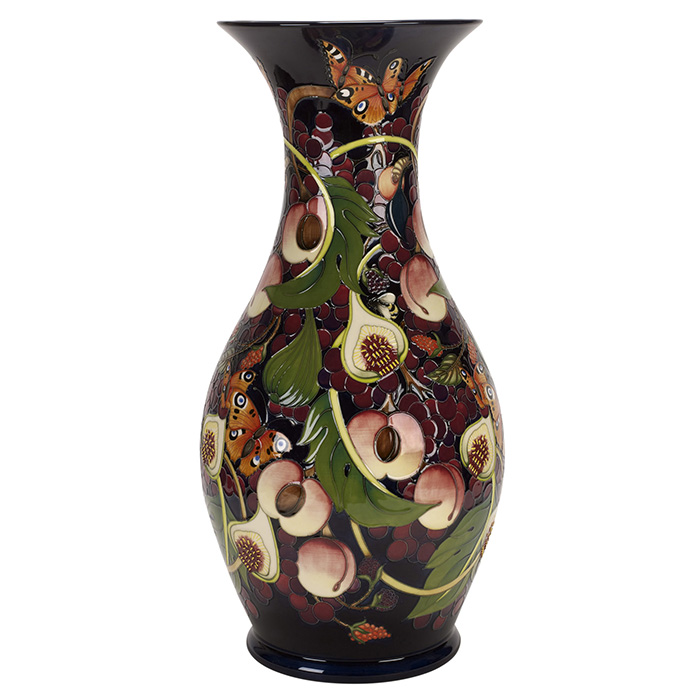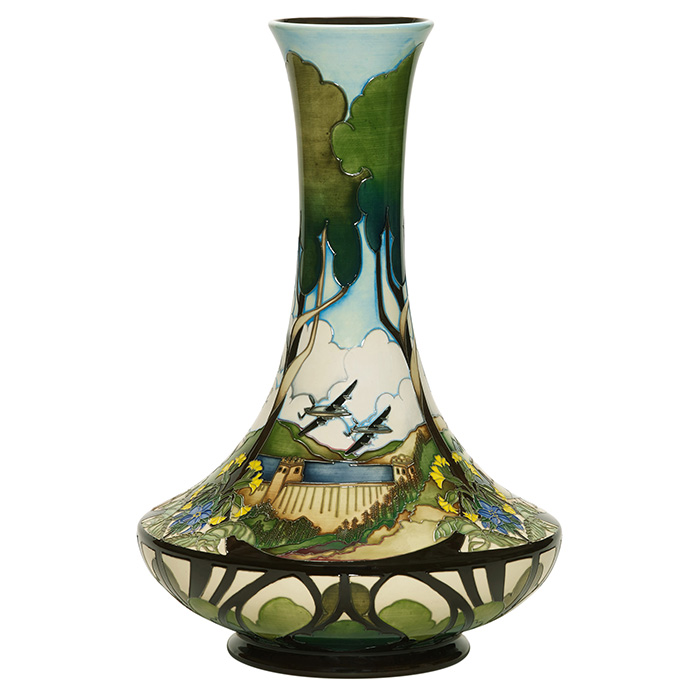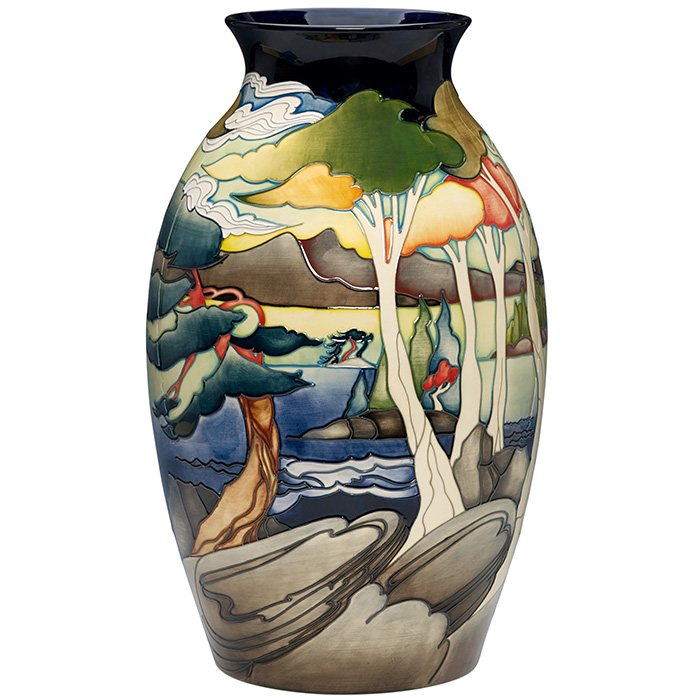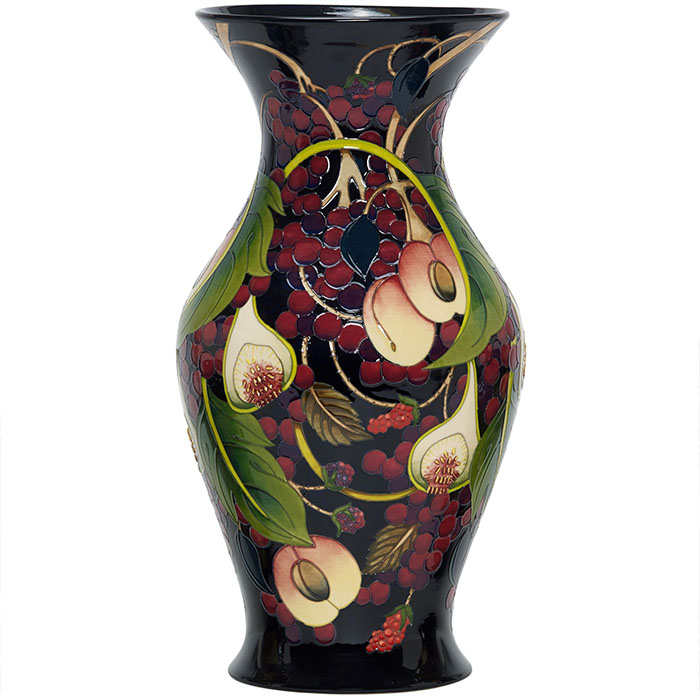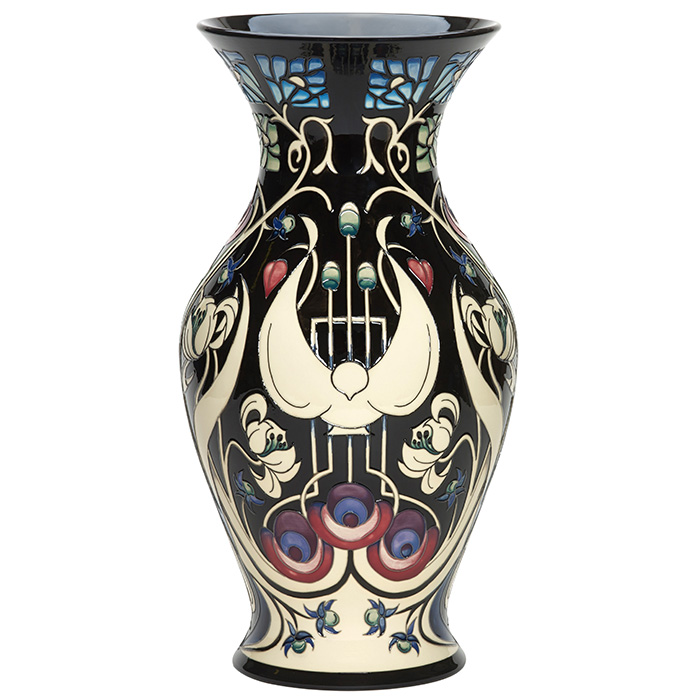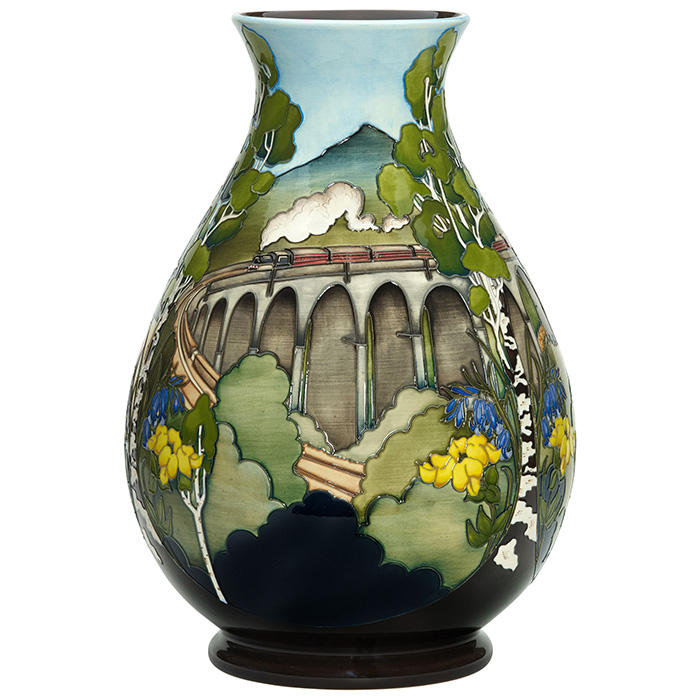Prestige Designs
MoorcroftPRestige designs
Prestige designs are amongst the most sought after pieces to emerge from Moorcroft’s kilns, and have been ever since the first pieces were made over a century ago. They are often pieces not only prestigious in size, but often with highly intricate, complex and captivating design subject matter. Due to the very nature of their size, which can be up to almost 70ms in height, it can take many weeks for a single piece to be made from start to finish. For this very reason the majority of prestige designs are made to order, due to limited capacity at Moorcroft’s 1913 factory in Stoke-on-Trent, but each piece is certainly worth waiting for, as few can surpass a Prestige Moorcroft vase.
A vast array of prestige vases made over the past 100 years can be seen on display in the Moorcroft Museum, each a breath-taking example of Moorcroft art pottery. The Jerusalem vase created to commemorate the new millennium in 2000, sold out within six weeks, each piece priced at over £11,000. In more recent times Prestige designs have been on display at the Lord Mayor of London’s Mansion House, Kensington Palace, Blackwell the Arts and Craft House, Cannon Hall, and The Potteries Museum and Art Gallery, with pieces such as the Glasgow School of Art creating international attention, as an homage to Charles Rennie Mackintosh.
Prestige pieces are often numbered or limited editions, and marked accordingly on the base. Here you will find the specific edition number of the piece, and additional appeal for the connoisseur comes from the fact that prestige pieces also carry the designers’ signature fired underglaze, as well as the informative array of Moorcroft markings.
Designer Anji Davenport
In 2000 Anji Davenport’s Woodside Farm was launched with great hope. For the first time, a countryside range designed with the innate emotions of a farmer’s daughter, Angela Davenport, captured the very spirit of winter. Anji returns with a prestige offering to excite the senses. Woodside Farm has now grown, more farm buildings have been erected and a vicarage now supports the church. This time the foxes have a new friend, and a barn owl oversees the quiet rumblings of a Massey Ferguson tractor. Sheep and cows quietly go about their business under a setting sun, and the walker can enjoy his wanderings amongst the sharpened colours of the tubelining. In the morning, the glistening white snow may no longer hark to this romantic rural idyll. For now, all can bask in the wonderful colours and imagery on this prestige vase.
Designer Paul Hilditch
A city’s gate becomes the docking port for the imagination. You wander into a world where horse drawn carriages stampede through streets filled with merchants scurrying around with barrels and baskets, as others stand in clusters displaying their ware and bartering. Set apart by their attire, gentlemen in top hats and ladies wearing long, bustled skirts and bonnets, walk proudly in tight, stiff collars, into architecture of a bygone time. Quaint, steep pitched roofs with overhangs and dormers allow the romanticism of ‘Merrie Olde England’ to engulf you. Epic in scale, this prestige vase can only be described as enchanting, with elegant black and white timber façades holding curiosities around every corner of this Hilditch masterpiece of Moorcroft design and tubelining.
Designer Nicola Slaney
Nicola’s design has its roots in the front cover of ‘Select Poems of Robert Burns.’ Two doves mirror each other in birdsong, framing a bouquet of Glasgow roses invented by Macintosh himself. Nicola selected many elements from this subculture of book cover art so the lines, arrows, hearts, leaves and dashes can be seen throughout. She had a deliberate colour scheme in mind before she designed Talwin, knowing that blacks, reds and pinks are synonymous with the style she was trying to recreate. As ever with Moorcroft designers, in all their work they bring their own perfunctory flare and we also see the very delicate greens and blues which Nicola is so often drawn to quite naturally herself. It is an absolute pleasure to see how Nicola continues to channel her devotion to, what she describes as, ‘one of my absolute favourite Moorcroft influences.’
Designer Kerry Goodwin
Situated on the east coast of Yorkshire at the mouth of the River Esk, Whitby has a rich maritime heritage, as it is said to be where Captain Cook learned his seamanship. It is also home to the ruins of Whitby Abbey where Caedmon, the earliest English poet, lived. Designer, Kerry Goodwin took inspiration from the picturesque setting and recreated this multi-coloured and charming harbour town.
Whitby radiates the uniquely nostalgic feel of an English harbour, to the point that you can almost hear the gulls screeching and wailing overhead and the smell of wet fish baskets and the tantalizing aroma of fish and chips, doused in salt and vinegar emanating from a harbour side building.
Kerry presents Whitby on a prestige vase giving the town the full honour it deserves as a destination of great historic interest. The size of this prestigious vase enables the full charm of the town to be seen by all.
Designer Rachel Bishop
Lieutenant Colonel John McCrae (1872-1918) an officer in the Canadian Army, wrote a poem called ‘In Flanders Field’ which reflected the sweet voice of creativity amidst the destructive forces of war. Rachel Bishop, touched by his words, decided to design a prestige vase which would restore a natural world almost destroyed by man and war by using a heavenly tune as her own personal tribute to all those of a brave and creative heart whose lives were stolen from them before their time. Delicate butterflies flutter effortlessly in fields of golden corn, while rich, blazing-red poppies rise triumphantly from the earth at the base of a fine, prestige vase.
Designer Nicola Slaney
Victorian graphic artist, Talwin Morris, was Nicola’s inspiration for this brilliant range of Moorcroft pieces, but as ever with Moorcroft designers, in all their work, bring their own individual flair. In Talwin we see very delicate greens and blues mixed subtly with, purples, reds and black. Nicola gladly shares this magnificent design said by Moorcroft to be one of the greatest collaborations between past and present in Moorcroft history. Moorcroft connoisseurs would wholeheartedly agree.
Designer Emma Bossons FRSA
Anyone with just the slightest interest in Moorcroft, will know that the work of Mackintosh has played a great role in the evolution of Moorcroft and, inevitably, has been a huge influence on Moorcroft designers. Mackintosh roses are a worldwide symbol of design excellence; his building designs have been a bedrock inspiration for modern architects. Emma’s evocative design, on this brand new Moorcroft shape, is a touching vision of the building lost to a devastating fire in May 2014. Emotive shades of blues and lilac are the only colours to grace the vase, in which delicately etched window panes meet iconic iron railings. With heads bowing in respect, Mackintosh’s willowy female forms wisp their way to the heavens, with heads crowned in dotted halos.
Designer Kerry Goodwin
Due to the popularity of the 2009 House of Flowers plaque Kerry Goodwin was invited to create a prestige version of her groundbreaking design. While the flowers on the vase remain the same, Kerry has added three additional landscape scenes between the flowers, each with a stylised garden gate. Each scene is different, some buildings have staircases, others have turrets or spires and all are in the Arts and Crafts style with tulips that burst into enchanting violet and burgundy hues as they soar up to the heavens. Each piece is numbered and signed.
Designer NICOLA SLANEY
There can be no mistaking the style of The May Queen, with its elegant, feminine linework and a muted colour palette, all of which speaks volumes for the name Mackintosh, lauded across the world. The May Queen was originally a panel in the ladies’ luncheon room situate inside Miss Cranston’s Ingram Street tearooms in Glasgow. The original panel was created by Margaret Macdonald Mackintosh, wife of Charles Rennie Mackintosh. No surprises here, doubly so because Nicola loves the subtle, warm colours that Margaret used. Her original panel was made to sit alongside its twin – an equally famous design called The Wassail, and as Nicola says, “You can look at The May Queen over and over again and still see new things”. It matters not how you study the images. The linework leads you on through stylised people, patterns, shapes and hieroglyphics and right into a place which is restful, beautiful and totally inspiring.
DesignerPAUL HILDITCH
Imagery of London, old and new, is captured on this prestige vase. It offers an architectural journey spanning an era from the early eighteenth century St Paul’s Cathedral to a contemporary building informally known as the Gherkin built in the heart of the City of London itself. Whilst the River Thames reflects the ever-changing city skyline above its banks, the river itself is a symbol of constancy in an ever-evolving world. Ornate lamp posts from a past age line the river’s edge, while red London buses trundle alongside the Thames, passing decades of culture and history on their way.
DesignerNICOLA SLANEY
Paul Saintenoy was one of Brussels’s most prominent architects, and he altered his house, built in 1872, by introducing Art Nouveau elements to it. Inside was one of the most beautiful Art Nouveau stained glass windows in Brussels created by craftsman Raphael Evaldre in c.1900. Based on an image by painter Henri Privat-Livemont, the window showcases a woman emerging from the centre of a swell of Japanese inspired waves. Called ‘La Vague’ (The Wave), the stained-glass window refers to the print The Great Wave off Kanagawa by Hokusai, in which a huge wave bears down on three boats.
Designer, Nicola Slaney, wanted to create a prestigious piece as part of the Art Nouveau Collection. Around the base of her chosen vase, an ethereal woman emerges from the sea, her hair adorned with seashells, together with seaweed intermingled amongst her own flowing locks. Above her is the sea itself, created by the clever use of small fan shaped blue arcs, which leads your eye to the sky which is infused with a soft, golden glow as the evening’s sun sets. In the evening, when lit from the interior, the window reveals all of its beauty, in the same way that Nicola’s prestige vase does over a century after Evaldre’s original creation.
Designer Emma Bossons FRSA
Queens Choice, considered by many to be the most successful Moorcroft range ever, was inspired by Shakespeare's play 'A Mid-Summer Night's Dream,'. Every fruit mentioned by Shakespeare in Queen Titania’s speech features in Emma's design 'Be kind and courteous to this gentleman; Hop in his walks and gambol in his eyes; Feed him with apricots and dewberries; With purple grapes, green figs and mulberries...'. All we need to do is to look at the linework and colour by lifting Emma’s remarkable collection and watch artistic history revealing itself in a contemporary idiom.
Designer Vicky Lovatt
In each third of the vase, Derwent Reservoir is pictured with the 617 Squadron practising the low-level flights needed for Operation Chastise or ‘Dam Busters’. Occasional flypasts of the Battle of Britain Memorial Flight at the reservoir are still staged to commemorate the events during the war. In September 2014, a unique and never to be repeated flypast took place involving the two remaining airworthy Lancasters, one from the Battle Of Britain Memorial Flight, and one from Canada, flying three passes in formation. On this prestige vase, that tribute is preserved forever.
Designer Emma Bossons FRSA
Collecting Moorcroft takes you on a journey of discovery. Not only do you come to possess a piece of Art Pottery from one of the last original firms of the Arts and Crafts movement, and a slice of Stoke-on-Trent ceramic history, but you also invite into your home, a world of inspired designs and stories from each corner of the globe. Group of Seven is no exception for it tells a tale about a group of Canadian landscape painters from 1920 to 1933, also sometimes known as the Algonquin School. Believing that a distinct Canadian art could be developed through direct contact with nature, the Group of Seven is best known for its paintings inspired by the Canadian landscape and initiated the first major Canadian national art movement.
Initially influenced by European Impressionism, the group pursued a new, original style using bright colours, tactile paint handling, and simple yet dynamic forms. They transfigured the Canadian Shield, the dense, northern boreal forest and endless lakes, into a transcendent, spiritual force.
Emma’s design takes elements from many different paintings from the movement. Waves and rocks mimic those of ‘September Gale, Georgian Bay’ by Arthur Lismer. Influences from ‘The Pine Tree’ by Tom Thomson can be seen in the tree branches. White whips in the clouds can also be found in ‘The Fire Ranger’ by Frank Johnston. Group of Seven is an interesting amalgamation of the unspoilt Canadian wilderness as seen through the eyes of several remarkable people, as inspiring now as they were almost 100 years ago.
DesignerEMMA BOSSONS FRSA
Queens Choice, considered by many to be the most successful Moorcroft range ever, was inspired by Shakespeare's play 'A Mid-Summer Night's Dream,'. Every fruit mentioned by Shakespeare in Queen Titania’s speech features in Emma's design 'Be kind and courteous to this gentleman; Hop in his walks and gambol in his eyes; Feed him with apricots and dewberries; With purple grapes, green figs and mulberries...'. All we need to do is to look at the linework and colour by lifting Emma’s remarkable collection and watch artistic history revealing itself in a contemporary idiom.
DesignerNICOLA SLANEY
Victorian graphic artist, Talwin Morris, was Nicola’s inspiration for this brilliant range of Moorcroft pieces, but as ever with Moorcroft designers, in all their work, bring their own individual flair. In Talwin we see very delicate greens and blues mixed subtly with, purples, reds and black. Nicola gladly shares this magnificent design said by Moorcroft to be one of the greatest collaborations between past and present in Moorcroft history. Moorcroft connoisseurs would wholeheartedly agree.
DesignerVICKY LOVATT
Towering above Loch Sheil, the great Jacobite steam train curves around the epic proportions of this prestige vase. A Jacobite statue of Bonnie Prince Charles stands next to the crystal-clear waters and clouded trees of silver birch and Caledonian pines, which soar into the skyline. Framed with bluebells, golden birds foot trefoil and foliage, the whistling steam train clatters over the Glenfinnan Viaduct, made famous through the Harry Potter films.
